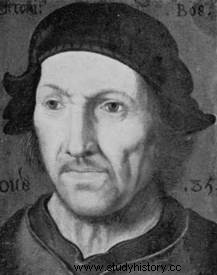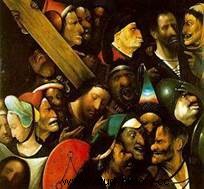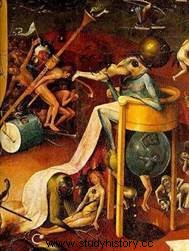 Hieronymus Bosch (c. 1450-1516) was a Flemish primitive painter of singular genius, famous for his fantastic iconography with an inexhaustible narrative sense, sometimes attributed to a popular tradition, sometimes to alchemy, but never far removed from the moral and religious concerns of his time. His art, at the crossroads of the Middle Ages and the Renaissance, describes a world that is both terrifying and enchanting, between paradise and hell. This genius with a tortured universe was one of the inspirations of the surrealist painters of the 20th century.
Hieronymus Bosch (c. 1450-1516) was a Flemish primitive painter of singular genius, famous for his fantastic iconography with an inexhaustible narrative sense, sometimes attributed to a popular tradition, sometimes to alchemy, but never far removed from the moral and religious concerns of his time. His art, at the crossroads of the Middle Ages and the Renaissance, describes a world that is both terrifying and enchanting, between paradise and hell. This genius with a tortured universe was one of the inspirations of the surrealist painters of the 20th century.
Origins and fame of Hieronymus Bosch
Our knowledge of the biography of Hieronymus Bosch, real name Hieronymus Van Aaken , are so far extremely lean. This one comes from a large family from Nijmegen and settled for three generations in Den Bosch (in Dutch, 's-Hertogenbosch):his father, Anthonius van Aken, was a painter, as well as his grandfather , Jan van Aken.
Hieronymus Bosch, who therefore chose the name of his birthplace as his surname, married around 1478 Aleit Vanden Mervenne, a woman from the region. In 1486-1487, he became a member of the lay brotherhood of Notre-Dame, a religious and charitable association dedicated to the veneration of the Virgin, thanks to which he acquired his entries among the notables of Bois-le-Duc and saw the artistic commissions flock. He soon became responsible for the design of the stained glass windows of the town church. His fame in Europe was immediate. His fame with the intellectual elite and the courts of Europe was immediate, both with Emperor Maximilian I, and his children Philip the Handsome and Margaret of Austria, or even Henry of Nassau, who were at the many of its most illustrious sponsors.
 A hallucinatory painting and critique of human passions
A hallucinatory painting and critique of human passions
Bosch's paintings are strongly distinguished by references to astrology, folklore, witchcraft, alchemy, the theme of the Antichrist and episodes of the lives of exemplary saints. They bear witness to a constant concern for the damnation of souls condemned to eternal hell, a fatal consequence of human madness refusing the virtue dictated by God. But one can also read, through the elaborate compositions of hybrid characters in extravagant positions (the Garden of Earthly Delights, Prado Museum, Madrid) as in the group scenes that give rise to incisive caricatures (the Conjurer, Museum of Saint-Germain-en-Laye), a satirical and moralizing spirit.
His very personal technique, called alla prima, consists of freely applying his motifs on a background prepared in dark tones (black, brown), and presupposes the knowledge of the great masters Germans of engraving, illumination and miniature.
The main works of Hieronymus Bosch
Of the known works of Bosch, none is dated and many of the panels that bear his signature may well be the work of his successors. His paintings were, in fact, highly appreciated and much imitated from the end of the 16th century, due to a real Bosnian revival, which occurred in Antwerp during the 1550s and in which artists such as Pieter Huys and Bruegel l'Art participated. Ancient, in infinite variations of his compositions. One of the main sources of identification of his paintings could however be established thanks to the descriptions meticulously established in the 16th century by Don Felipe Guevara, Spanish aristocrat.

Thanks to the dendrochronological expertise recently carried out on the painted panels — determining the age of a panel by counting the growth rings of the wood —, the Jardin des délices (museum of the Prado), long considered a work of maturity (after 1500), is today regarded as an early work (1480-1490). Similarly, it was able to be established in the same way that the Colporteur de Madrid was in fact only the reverse of a triptych comprising on its interior face, the Ship of Fools (Paris), the Allegory of Gluttony ( New Haven) and Death of a Miser (National Gallery of Art, Washington). Similarly, if the works dealing with the life and Passion of Christ — Christ carrying the cross (musée voor Schone Kunsten, Ghent), Crucifixion (royal museums of Fine Arts of Belgium, Brussels) — are considered to be even later, the painting of the Wedding at Cana (Boijmans Van Beuningen Museum, Rotterdam) is no longer considered to be by Bosch. It would be fifty years after the Master's death.
In this regard, the exhibition held in 2001 at the Boijmans Van Beuningen museum — and featuring 18 of the 25 attested wood panels by Hieronymus Bosch and 7 of his 8 drawings — made it possible to bring these very recent expert reports to the general public. She has thus contributed to shedding new light on the personality and work of Bosch.
To go further
- Hieronymus Bosch by Roger Van Schoute. 2007.
- The ABCdaire of Jérôme Bosch, by Roger-Henri Marijnissen. Flammarion, 2001.
- Hieronymus Bosch:The Garden of Earthly Delights by Hans Belting. Gallimard, 2005.
